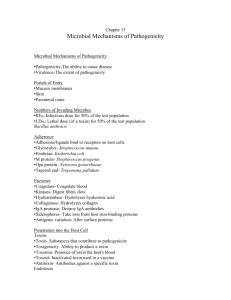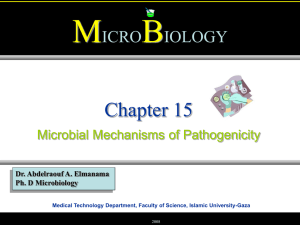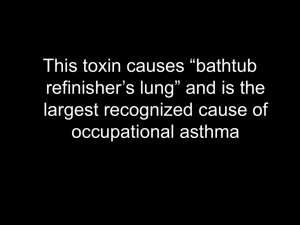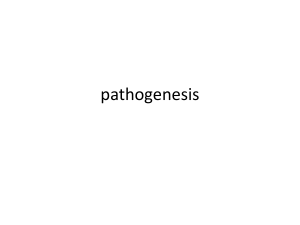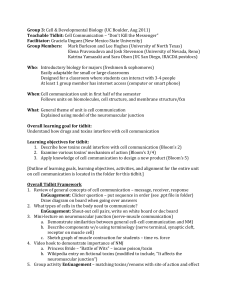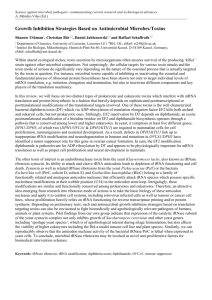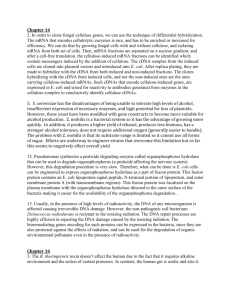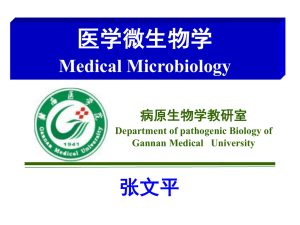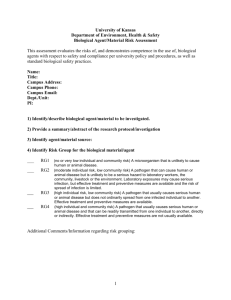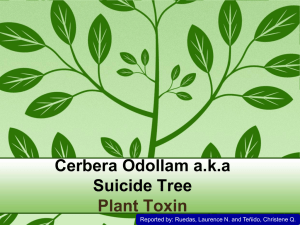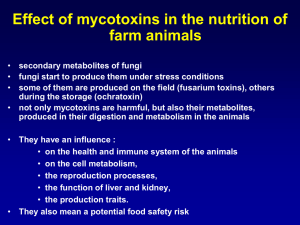Lec 8 Microbial mechanisms of pathogenicity
advertisement
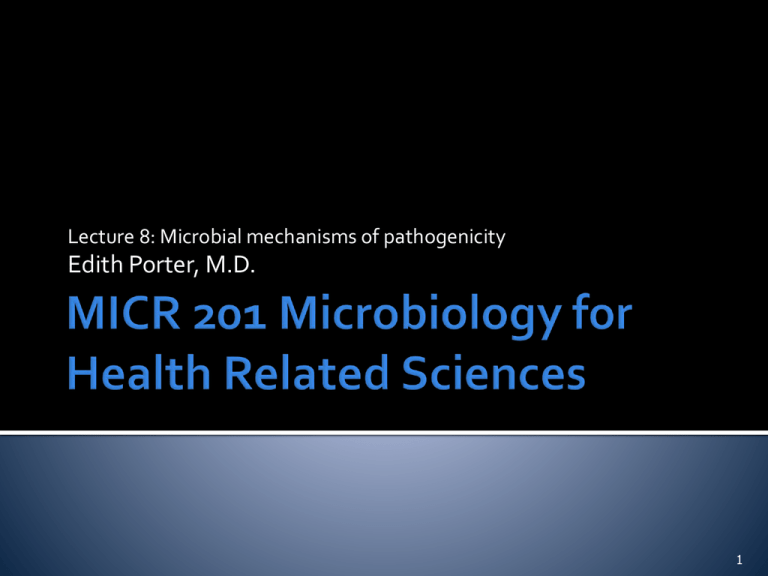
Lecture 8: Microbial mechanisms of pathogenicity Edith Porter, M.D. 1 Important definitions The infection cycle Bacterial pathogenesis ▪ How bacteria enter and invade a host ▪ How bacteria circumvent host defenses ▪ How bacteria damage host cells Pathogenic properties of viruses Pathogenic properties of fungi, protozoa, and helminths 2 Pathogenicity The ability to cause disease Virulence The extent or degree of pathogenicity Obligate pathogen (pathogen) Causes disease in the healthy adult by means of specific pathogenic factors Typically not part of the normal microbiota Opportunist Causes disease only in individuals with locally or systemically compromised immune function Often part of the normal microbiota ID50: Infectious dose for 50% of the test population LD50: Lethal dose for 50% of the test population Disease Disease Health Health Disease Health Mucous membranes Parenteral route Skin Penetration through intact skin Schistosoma mansoni Trematode (Fluke), with male and female worms, live in blood vessels Bacillus anthracis Portal of entry ID50 Skin 10-50 endospores Inhalation 10,000-20,000 endospores Ingestion 250,000-1,000,000 endospores Respiratory tract Coughing, sneezing Gastrointestinal tract Feces, saliva Genitourinary tract Urine, semen, vaginal secretions Skin Blood Biting arthropods, needles/syringes Exit route is typically the same as entry route Entry Adherence Penetration Enzyme and toxin production Direct damage to host Evasion of host defense Resistance to uptake by phagocytes Change of surface molecule expression Latency (hiding in host cells) Degradation of host defense molecules Adhesins bind to specific receptors on host cells Adhesin Bacterial strain Glycocalyx Streptococcus mutans (plaque) Fimbriae (pili) Escherichia coli (UTI) M protein Streptococcus pyogenes Opa protein Neisseria gonorrhoeae (transcytosis) Neisseria gonorrhoeae initiates receptor mediated uptake by urethral or cervical epithelial cells Salmonella typhimurium invades intestinal epithelial cells using their cell surface protein invasin (rearranges the cytoskeleton) Coagulase Kinases Streptokinase* Digest fibrin clots Hyaluronidase* Coagulates blood (S. aureus, thick pus) Hydrolyses hyaluronic acid Facilitate tissue degradation and spreading Collagenase Hydrolyzes collagen * Therapeutic use! Toxin Poisonous substance Presence of toxin the host's Molecule that contributes to pathogenicity Toxigenicity blood Toxicity Ability to induce toxic reactions in host Toxoid Inactivated toxin used in a Capacity of a microbe to produce toxin Toxigenic strains: strains producing toxins Toxemia vaccine Antitoxin Neutralizing antibodies against a specific toxin Secreted by the microbe Act locally and in a distance Typically proteins AB toxins: inactivate essential cell functions Membrane disrupting toxins Toxins overstimulating immune system 17 C. diphteriae Toxins with 2 sub units: A: Active component, mediates toxicity B: Binding component, guides toxin to the target cell Example: Diptheria toxin ▪ Inhibits elongation factor II in ribosomes, inhibits protein synthesis ▪ 0.01 mg can kill a 200 lb person http://www.sumanasinc.com/webcontent/ani mations/content/diphtheria.html 19 Diphteria Membrane Disrupt host cell plasma membrane Depending on target: Hemolysins: erythrocytes Leukocidins: phagocytes Some destroy also other cell types SLO-Pores (Bhakdi et al) Examples: Pore forming ▪ S. aureus alpha toxin ▪ S. pyogenes streptolysin -O and -S Enzymatic ▪ C. perfringens phospholipase C Gas Gangrene Producer Exotoxin S. pyogenes Streptolysins (membrane-disrupting) Erythrogenic toxin* (scarlet fever) S. aureus TSST (hyperstimulate immune system) Enterotoxins* (similar to V. cholerae toxin) C. diphtheriae Diphteria toxin* (A-B toxin, inhibits protein synthesis) C. botulinum Neurotoxin (A-B toxin, flaccid paralysis) C. tetani Neurotoxin (A-B toxin, muscle contractions) V. cholerae Enterotoxin (A-B toxin, diarrhea) *phage coded LPS (lipopolysaccharide) Component of outer membrane of gramnegative bacteria Triggers fever! Pyrogen Capsules M-protein in Streptococci Intracellular survival Escape into cytoplasma ▪ Rickettsia Resistance against antimicrobial factors ▪ M. tuberculosis with lipids Trypanosoma Assume host molecules Shedding of surface N. gonorrhoeae Undulating Membrane Schistosoma Vary surface glycoprotein 1 of 1000 genes expressed at a time Genes randomly switched on and off Vary outer membrane protein (opa) Influenza virus Changes in spikes Trypanosome cruzi Microbial agent (virus) retreats in host cells HIV in Lymphocytes Herpes viridae in Nerve cells Herpes simplex ▪ Fever blister Varizella Zoster Virus ▪ Chicken pox ▪ Latency in dorsal root ganglion ▪ Recurrence: zoster in skin cells Many mucosal pathogens produce IgAproteases Degrade antibody type A Negri bodies in rabies Inclusion bodies Cell rounding Cell aggregation Syncytium: multinucleated cells Inactivation of host defense cells (HIV) Down regulation of host defense Transformation: loss of contact inhibition, uninhibited growth Cancerogenic oncogens Transformed cells in culture Chronic infections provoke an allergic response Toxins Ergot toxin: Claviceps, Hallucinations, LSD like, abortions Aflatoxin: Primary liver cancer Mycotoxin: amanitin, neurotoxin, death Presence of protozoa Protozoan waste products and products released from damaged tissue may cause symptoms Avoid host defenses by Growing in phagocytes Antigenic variation Helminth body mass can block host liquid movement Ileus with Ascaris infection Elephantiasis (Filaria infection blockage of lymph vessels) Elephantiasis Filaria Adult Can survive for 5 – 10 y Virulence determined by invading microorganism and host defense Entry route is typically same as exit route Main pathogenic factors: Promote entry Damage host ▪ Enzyme and toxin production ▪ Toxins often phage coded Evasion of host defense Disease is a combination of direct cell damage and host defense response http://www.doctorfungus.com/thefungi/Cryptococcus.htm http://www.geo.ucalgary.ca/~macrae/palynology/dinoflagellates/din oflagellates.html • http://www.mikrobiologie.medizin.uni-mainz.de/de/index.html Primary Literature available on request

